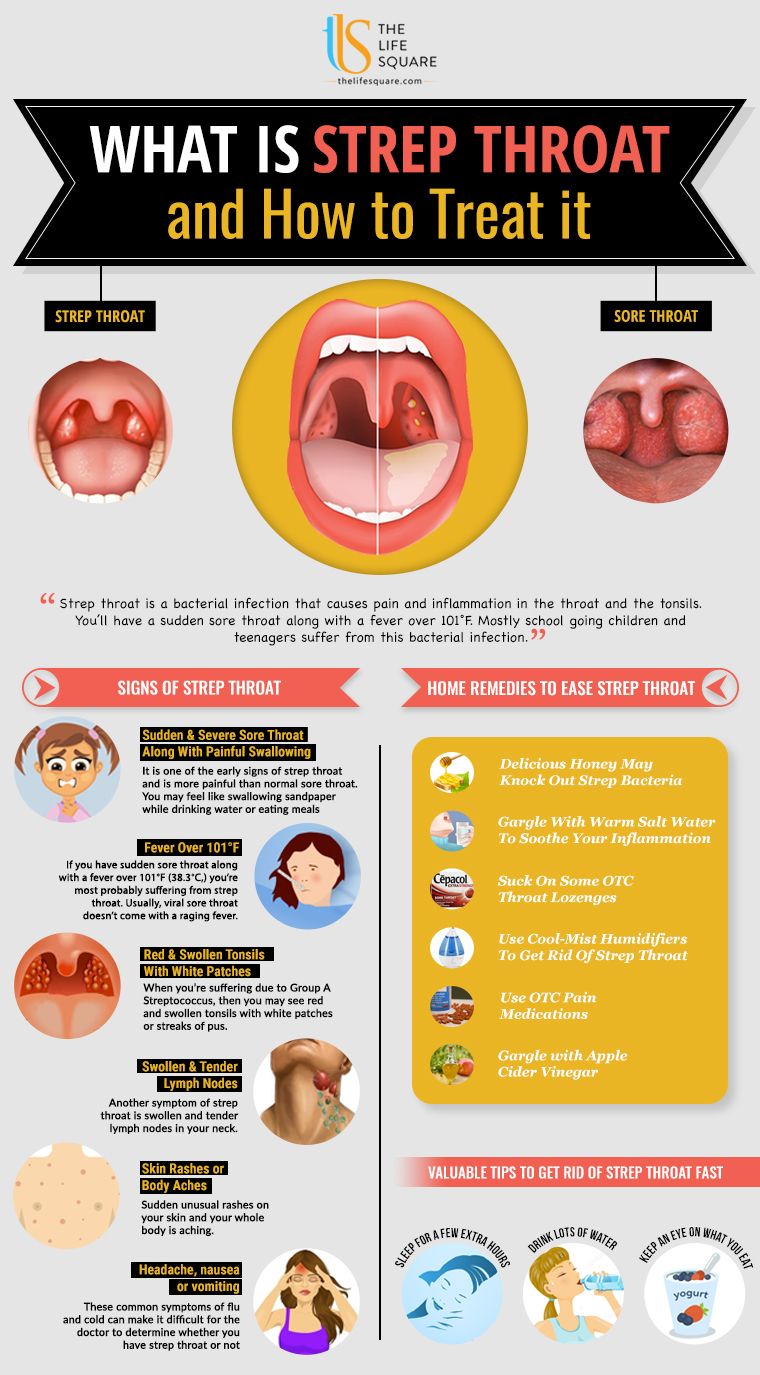Strep throat symptoms in teens. Strep Throat in Teens: Symptoms, Causes, and Prevention
What are the common symptoms of strep throat in teenagers. How is strep throat diagnosed and treated. What complications can arise from untreated strep throat. How can teens prevent contracting strep throat.
Understanding Strep Throat: A Common Bacterial Infection
Strep throat is a bacterial infection caused by Streptococcus pyogenes, also known as group A streptococcus. While it can affect people of all ages, it’s particularly common among children and teenagers. This infection is characterized by a sore, scratchy throat that typically develops quickly and can be accompanied by several other symptoms.
How does strep throat differ from other throat infections? Unlike viral throat infections, which are more common, strep throat is caused by bacteria and requires antibiotic treatment. It’s important to distinguish between the two, as proper diagnosis leads to appropriate treatment.
Recognizing Strep Throat Symptoms in Teenagers
Identifying strep throat early is crucial for prompt treatment and prevention of complications. Teenagers with strep throat may experience a range of symptoms, including:
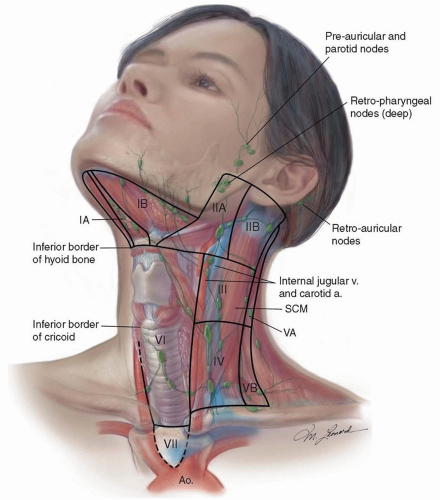
- Sudden onset of throat pain
- Difficulty swallowing
- Swollen, red tonsils (sometimes with white patches or pus)
- Tiny red spots on the soft or hard palate
- Swollen, tender lymph nodes in the neck
- Fever
- Headache
- Body aches
- Nausea or vomiting
- Rash
Is it possible to have strep throat without all these symptoms? Yes, some teenagers may only experience a few of these symptoms, while others might have most of them. It’s also important to note that having these symptoms doesn’t necessarily mean a teen has strep throat, as other illnesses can cause similar symptoms.
Diagnosing Strep Throat: When to See a Doctor
Given the similarity of strep throat symptoms to other conditions, medical evaluation is essential for accurate diagnosis. Parents should consider taking their teenager to a doctor if they experience:
- A sore throat lasting longer than 48 hours
- A sore throat accompanied by swollen, tender lymph nodes
- Fever
- A sore throat with a rash
- Difficulty breathing or swallowing
How do doctors diagnose strep throat? Typically, a doctor will perform a rapid strep test, which involves swabbing the throat and can provide results within minutes. If this test is negative but strep is still suspected, a throat culture may be done, which takes longer but is more accurate.

Treatment Options for Strep Throat in Teens
Once diagnosed, strep throat is typically treated with antibiotics. The most commonly prescribed antibiotics include:
- Penicillin
- Amoxicillin
- Cephalosporins (for those allergic to penicillin)
How long does it take for antibiotics to work? While symptoms may start to improve within a day or two of starting antibiotics, it’s crucial to complete the entire course as prescribed, usually 10 days. This helps prevent the infection from returning and reduces the risk of complications.
In addition to antibiotics, the following measures can help alleviate symptoms:
- Getting plenty of rest
- Drinking warm liquids
- Using throat lozenges
- Taking over-the-counter pain relievers like ibuprofen or acetaminophen
- Gargling with salt water
Potential Complications of Untreated Strep Throat
While strep throat itself is usually not serious, if left untreated, it can lead to several complications. These include:
- Spread of infection to other parts of the body, such as:
- Tonsils
- Sinuses
- Skin
- Blood
- Middle ear
- Inflammatory reactions:
- Scarlet fever
- Kidney inflammation (poststreptococcal glomerulonephritis)
- Rheumatic fever
- Poststreptococcal reactive arthritis
Can strep throat lead to heart problems? In rare cases, untreated strep throat can lead to rheumatic fever, which can damage heart valves. This underscores the importance of proper diagnosis and treatment.

Preventing Strep Throat: Practical Tips for Teens
While it’s not always possible to prevent strep throat, there are several measures teenagers can take to reduce their risk of infection:
- Proper hand hygiene: Wash hands frequently with soap and water for at least 20 seconds, or use an alcohol-based hand sanitizer when soap and water aren’t available.
- Practice good respiratory etiquette: Cover the mouth and nose with a tissue or elbow when coughing or sneezing.
- Avoid sharing personal items: Don’t share drinking glasses, eating utensils, or other personal items.
- Maintain a healthy lifestyle: A balanced diet, regular exercise, and adequate sleep can help support the immune system.
How effective is hand washing in preventing strep throat? Regular hand washing is one of the most effective ways to prevent the spread of many infections, including strep throat. It’s especially important before eating and after being in public places.
Strep Throat and School: What Teens Need to Know
Strep throat can significantly impact a teenager’s school life. Here are some important points to consider:

- Stay home: Teens with strep throat should stay home from school until they’ve been on antibiotics for at least 24 hours and no longer have a fever.
- Catch up on schoolwork: Work with teachers to catch up on missed assignments.
- Avoid close contact: Upon returning to school, avoid close contact with others for the first few days to prevent spreading the infection.
When is it safe for a teen with strep throat to return to school? Generally, if a teen has been on antibiotics for 24 hours, no longer has a fever, and feels well enough, they can return to school. However, it’s always best to consult with a healthcare provider for personalized advice.
The Link Between Strep Throat and Other Health Conditions
Recent research has suggested potential links between strep throat and other health conditions, particularly in children and teenagers. One such condition is Pediatric Autoimmune Neuropsychiatric Disorders Associated with Streptococcal Infections (PANDAS).
What is PANDAS and how is it related to strep throat? PANDAS is a condition where children experience sudden onset or worsening of neuropsychiatric symptoms, such as obsessive-compulsive disorder (OCD) or tic disorders, following a strep throat infection. However, it’s important to note that this relationship is still being studied and remains somewhat controversial in the medical community.

Other potential links being investigated include:
- Psoriasis: Some studies suggest that strep infections may trigger psoriasis in genetically susceptible individuals.
- Guttate psoriasis: This form of psoriasis is often triggered by strep throat in children and young adults.
- Reactive arthritis: In rare cases, strep throat can lead to inflammation in the joints.
While these connections are intriguing, more research is needed to fully understand the relationship between strep throat and these conditions. Parents and teens should be aware of these potential links and discuss any concerns with their healthcare provider.
Strep Throat in the Context of COVID-19
The ongoing COVID-19 pandemic has added a layer of complexity to diagnosing and managing strep throat. Both conditions can present with similar symptoms, such as sore throat and fever, leading to potential confusion.
How can one differentiate between strep throat and COVID-19? While there is some overlap in symptoms, there are key differences:

- Strep throat typically doesn’t cause coughing or shortness of breath, which are common in COVID-19.
- Loss of taste or smell is more associated with COVID-19 than strep throat.
- Strep throat often causes more severe throat pain and difficulty swallowing compared to COVID-19.
Given the potential for confusion, it’s crucial for teens experiencing symptoms to seek medical advice. Healthcare providers can perform the necessary tests to differentiate between strep throat, COVID-19, and other conditions.
Long-Term Health Implications of Recurring Strep Throat
While most cases of strep throat resolve without complications, some teenagers may experience recurrent infections. This can have several implications:
- Increased risk of complications: Frequent infections may increase the risk of developing complications like rheumatic fever.
- Tonsillectomy consideration: In cases of very frequent strep throat, doctors might consider recommending a tonsillectomy (surgical removal of the tonsils).
- Carrier state: Some individuals may become asymptomatic carriers of strep bacteria, potentially spreading the infection to others.
When should a tonsillectomy be considered for recurrent strep throat? The criteria can vary, but generally, if a teen has had seven or more cases of strep throat in one year, five cases per year for two consecutive years, or three cases per year for three consecutive years, a tonsillectomy might be recommended. However, this decision should be made in consultation with a healthcare provider, considering the individual’s overall health and specific circumstances.

The Role of Nutrition in Fighting and Preventing Strep Throat
While proper nutrition can’t prevent strep throat entirely, a balanced diet can support the immune system, potentially helping the body fight off infections more effectively. Some nutritional considerations for teens prone to strep throat include:
- Vitamin C: Found in citrus fruits, berries, and leafy greens, vitamin C can help boost immune function.
- Zinc: Present in lean meats, nuts, and seeds, zinc plays a crucial role in immune health.
- Probiotics: Found in yogurt and other fermented foods, probiotics may help maintain a healthy balance of bacteria in the body.
- Hydration: Drinking plenty of water helps keep the throat moist and can alleviate some discomfort during an infection.
Can certain foods help soothe a sore throat during strep infection? While not a cure, some foods can provide temporary relief from throat pain. These include warm broths, herbal teas with honey, cold treats like popsicles, and soft foods that are easy to swallow.

The Psychological Impact of Strep Throat on Teenagers
While the physical symptoms of strep throat are well-documented, the psychological impact on teenagers is often overlooked. Recurring or severe cases of strep throat can affect a teen’s life in several ways:
- Social isolation: Frequent illnesses can lead to missing social events and feeling isolated from peers.
- Academic stress: Missing school due to illness can cause anxiety about falling behind in studies.
- Sports and extracurricular activities: Strep throat can interfere with a teen’s ability to participate in sports and other activities they enjoy.
- Self-esteem: Chronic illness can sometimes affect a teenager’s self-image and confidence.
How can parents support their teen’s mental health during and after strep throat? Open communication is key. Parents should encourage their teens to express their feelings about their illness and its impact on their life. Providing reassurance, helping them stay connected with friends (even if virtually), and working with school officials to manage academic responsibilities can all help alleviate stress and anxiety associated with strep throat.
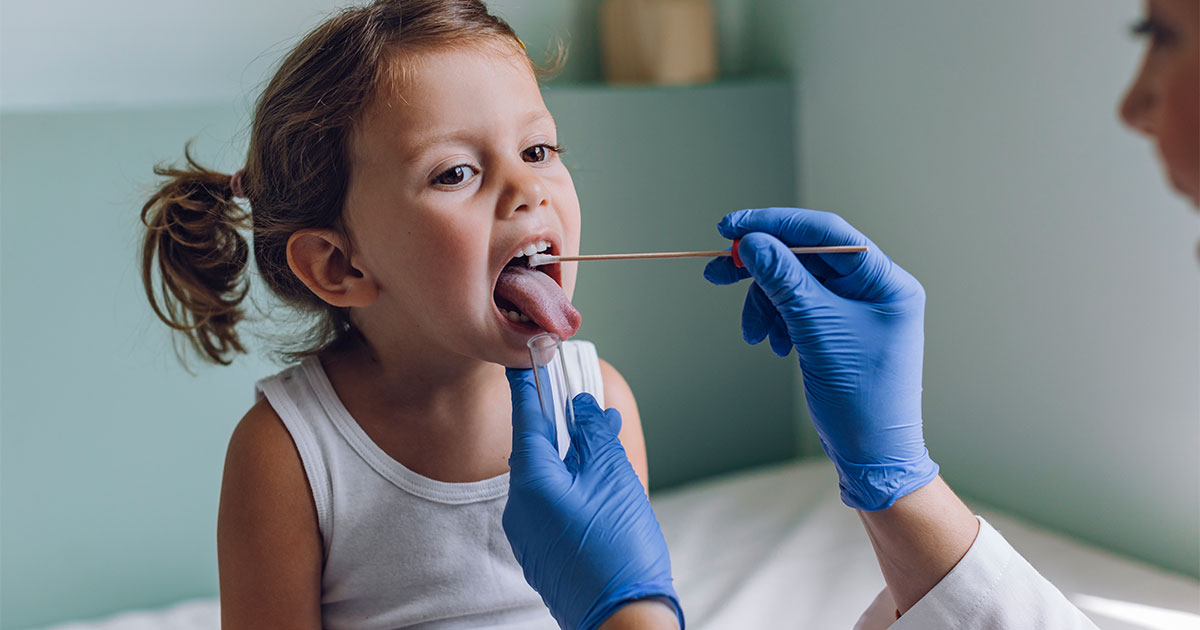
Emerging Research and Future Directions in Strep Throat Management
The field of strep throat research continues to evolve, with several exciting areas of study that could impact future prevention and treatment strategies:
- Vaccine development: Researchers are working on developing a vaccine against group A streptococcus, which could potentially prevent strep throat and its complications.
- Rapid diagnostic tests: New technologies are being developed to provide even faster and more accurate diagnosis of strep throat.
- Alternative treatments: Studies are exploring the potential of natural remedies and alternative therapies to complement traditional antibiotic treatment.
- Microbiome research: Understanding the role of the throat microbiome in susceptibility to strep infections could lead to new preventive strategies.
What potential impact could a strep throat vaccine have? If successfully developed and widely implemented, a strep throat vaccine could significantly reduce the incidence of strep infections and their complications. This could lead to fewer missed school days, reduced antibiotic use, and a lower risk of serious complications like rheumatic fever.

As research progresses, it’s important for teenagers and their parents to stay informed about new developments in strep throat prevention and treatment. Regular check-ups and open communication with healthcare providers can ensure that teens receive the most up-to-date and effective care for strep throat and related conditions.
Strep throat – Symptoms & causes
Overview
Strep throat is a bacterial infection that can make your throat feel sore and scratchy. Strep throat accounts for only a small portion of sore throats.
If untreated, strep throat can cause complications, such as kidney inflammation or rheumatic fever. Rheumatic fever can lead to painful and inflamed joints, a specific type of rash, or heart valve damage.
Strep throat is most common in children, but it affects people of all ages. If you or your child has signs or symptoms of strep throat, see your doctor for prompt testing and treatment.
Products & Services
Symptoms
Signs and symptoms of strep throat can include:
- Throat pain that usually comes on quickly
- Painful swallowing
- Red and swollen tonsils, sometimes with white patches or streaks of pus
- Tiny red spots on the area at the back of the roof of the mouth (soft or hard palate)
- Swollen, tender lymph nodes in your neck
- Fever
- Headache
- Rash
- Nausea or vomiting, especially in younger children
- Body aches
Strep throat infection
Strep throat usually causes throat pain and difficulty swallowing. This photo of strep throat shows inflammation and red spots, caused by the infection.
This photo of strep throat shows inflammation and red spots, caused by the infection.
It’s possible for you or your child to have many of these signs and symptoms but not have strep throat. The cause of these signs and symptoms could be a viral infection or some other illness. That’s why your doctor generally tests specifically for strep throat.
It’s also possible for you to be exposed to a person who carries strep but shows no symptoms.
When to see a doctor
Call your doctor if you or your child has any of these signs and symptoms:
- A sore throat accompanied by tender, swollen lymph glands
- A sore throat that lasts longer than 48 hours
- A fever
- A sore throat accompanied by a rash
- Problems breathing or swallowing
- If strep has been diagnosed, a lack of improvement after taking antibiotics for 48 hours
Causes
Strep throat is caused by infection with a bacterium known as Streptococcus pyogenes, also called group A streptococcus.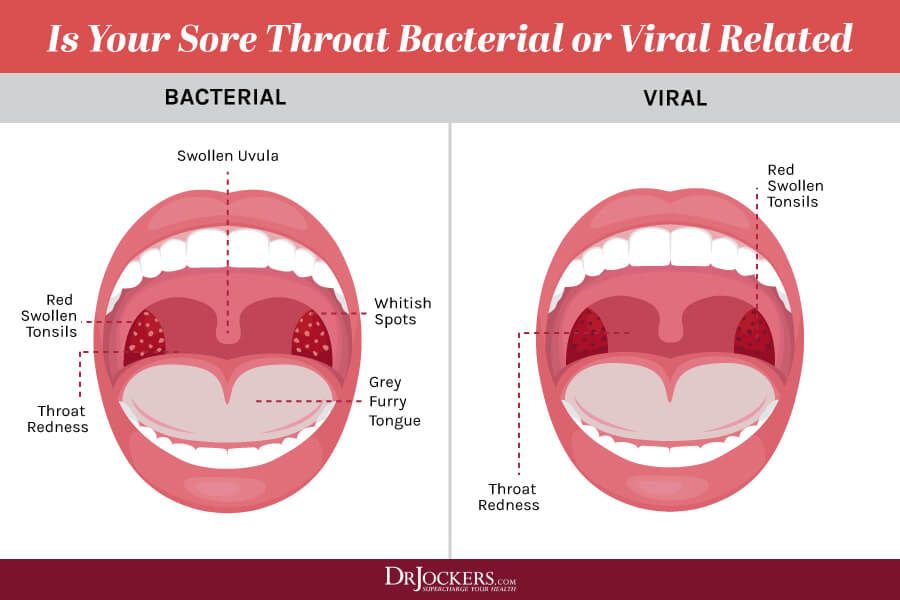
Streptococcal bacteria are contagious. They can spread through droplets when someone with the infection coughs or sneezes, or through shared food or drinks. You can also pick up the bacteria from a doorknob or other surface and transfer them to your nose, mouth or eyes.
Risk factors
Several factors can increase your risk of strep throat infection:
- Young age. Strep throat occurs most commonly in children.
- Time of year. Although strep throat can occur anytime, it tends to circulate in winter and early spring. Strep bacteria flourish wherever groups of people are in close contact.
Complications
Strep throat can lead to serious complications. Antibiotic treatment reduces the risk.
Spread of infection
Strep bacteria may spread, causing infection in:
- Tonsils
- Sinuses
- Skin
- Blood
- Middle ear
Inflammatory reactions
Strep infection may lead to inflammatory illnesses, including:
- Scarlet fever, a streptococcal infection characterized by a prominent rash
- Inflammation of the kidney (poststreptococcal glomerulonephritis)
- Rheumatic fever, a serious inflammatory condition that can affect the heart, joints, nervous system and skin
- Poststreptococcal reactive arthritis, a condition that causes inflammation of the joints
A possible relationship has been suggested between strep infection and a rare condition called pediatric autoimmune neuropsychiatric disorder associated with group A streptococci (PANDAS).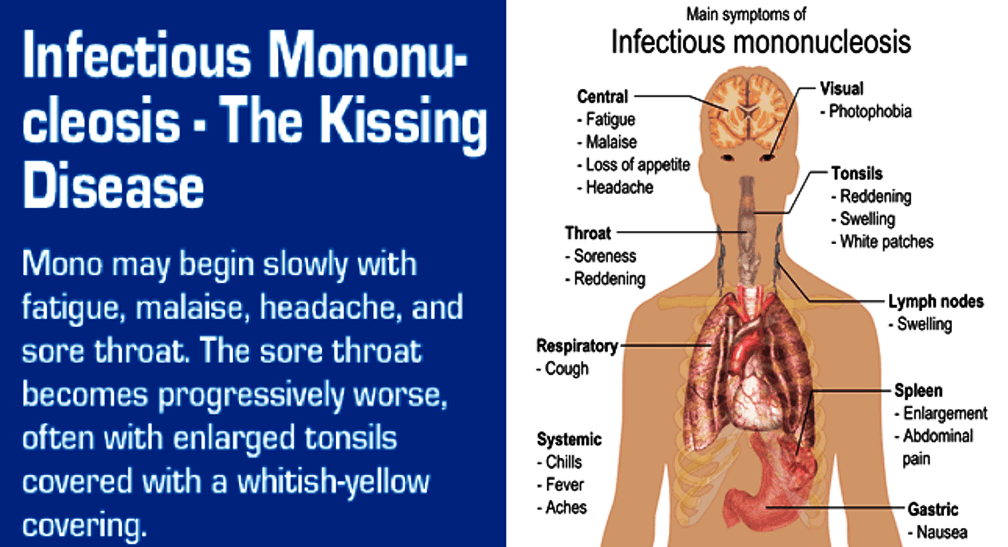 Children with this condition experience worsened symptoms of neuropsychiatric conditions, such as obsessive-compulsive disorder or tic disorders, with strep. This relationship currently remains unproved and controversial.
Children with this condition experience worsened symptoms of neuropsychiatric conditions, such as obsessive-compulsive disorder or tic disorders, with strep. This relationship currently remains unproved and controversial.
Prevention
To prevent strep infection:
- Wash your hands. Proper hand-washing is the best way to prevent all kinds of infections. That’s why it’s important to wash your own hands regularly with soap and water for at least 20 seconds. Teach your children how to wash their hands properly using soap and water or to use an alcohol-based hand sanitizer if there is no soap and water available.
- Cover your mouth. Teach your children to cover their mouths with an elbow or tissue when they cough or sneeze.
- Don’t share personal items. Don’t share drinking glasses or eating utensils. Wash dishes in hot, soapy water or in a dishwasher.
Strep throat – Symptoms & causes
Overview
Strep throat is a bacterial infection that can make your throat feel sore and scratchy.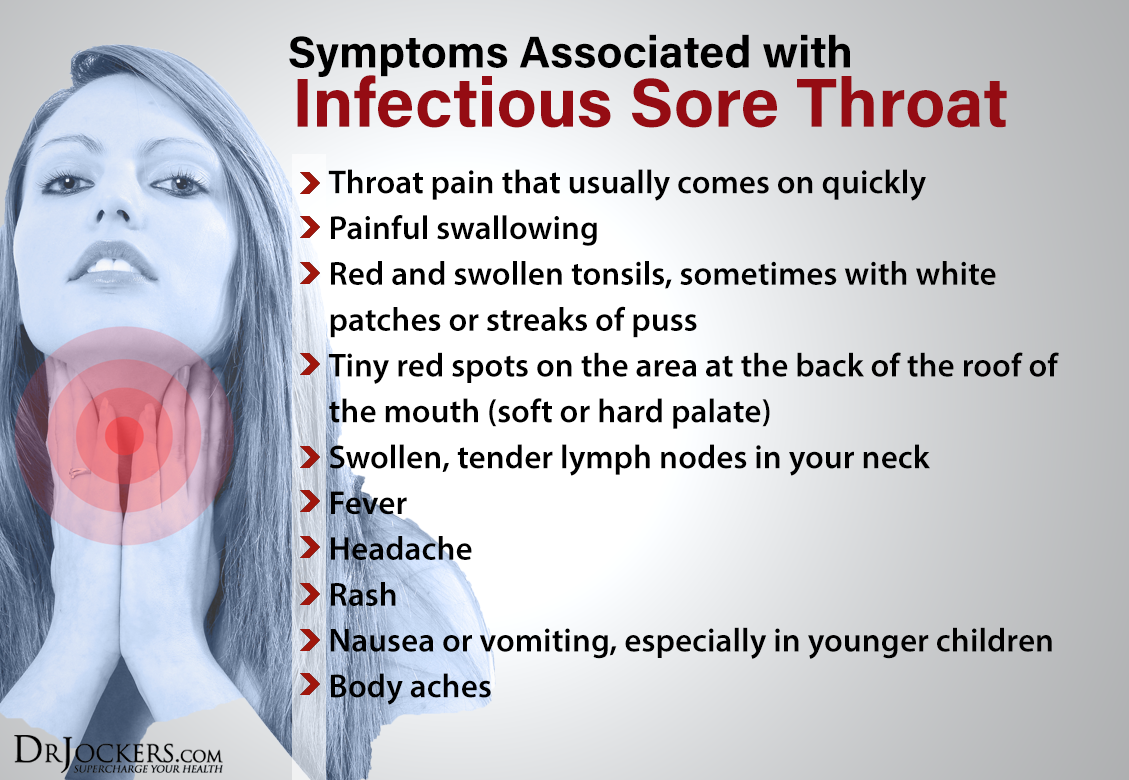 Strep throat accounts for only a small portion of sore throats.
Strep throat accounts for only a small portion of sore throats.
If untreated, strep throat can cause complications, such as kidney inflammation or rheumatic fever. Rheumatic fever can lead to painful and inflamed joints, a specific type of rash, or heart valve damage.
Strep throat is most common in children, but it affects people of all ages. If you or your child has signs or symptoms of strep throat, see your doctor for prompt testing and treatment.
Products & Services
Symptoms
Signs and symptoms of strep throat can include:
- Throat pain that usually comes on quickly
- Painful swallowing
- Red and swollen tonsils, sometimes with white patches or streaks of pus
- Tiny red spots on the area at the back of the roof of the mouth (soft or hard palate)
- Swollen, tender lymph nodes in your neck
- Fever
- Headache
- Rash
- Nausea or vomiting, especially in younger children
- Body aches
Strep throat infection
Strep throat usually causes throat pain and difficulty swallowing. This photo of strep throat shows inflammation and red spots, caused by the infection.
This photo of strep throat shows inflammation and red spots, caused by the infection.
It’s possible for you or your child to have many of these signs and symptoms but not have strep throat. The cause of these signs and symptoms could be a viral infection or some other illness. That’s why your doctor generally tests specifically for strep throat.
It’s also possible for you to be exposed to a person who carries strep but shows no symptoms.
When to see a doctor
Call your doctor if you or your child has any of these signs and symptoms:
- A sore throat accompanied by tender, swollen lymph glands
- A sore throat that lasts longer than 48 hours
- A fever
- A sore throat accompanied by a rash
- Problems breathing or swallowing
- If strep has been diagnosed, a lack of improvement after taking antibiotics for 48 hours
Causes
Strep throat is caused by infection with a bacterium known as Streptococcus pyogenes, also called group A streptococcus.
Streptococcal bacteria are contagious. They can spread through droplets when someone with the infection coughs or sneezes, or through shared food or drinks. You can also pick up the bacteria from a doorknob or other surface and transfer them to your nose, mouth or eyes.
Risk factors
Several factors can increase your risk of strep throat infection:
- Young age. Strep throat occurs most commonly in children.
- Time of year. Although strep throat can occur anytime, it tends to circulate in winter and early spring. Strep bacteria flourish wherever groups of people are in close contact.
Complications
Strep throat can lead to serious complications. Antibiotic treatment reduces the risk.
Spread of infection
Strep bacteria may spread, causing infection in:
- Tonsils
- Sinuses
- Skin
- Blood
- Middle ear
Inflammatory reactions
Strep infection may lead to inflammatory illnesses, including:
- Scarlet fever, a streptococcal infection characterized by a prominent rash
- Inflammation of the kidney (poststreptococcal glomerulonephritis)
- Rheumatic fever, a serious inflammatory condition that can affect the heart, joints, nervous system and skin
- Poststreptococcal reactive arthritis, a condition that causes inflammation of the joints
A possible relationship has been suggested between strep infection and a rare condition called pediatric autoimmune neuropsychiatric disorder associated with group A streptococci (PANDAS). Children with this condition experience worsened symptoms of neuropsychiatric conditions, such as obsessive-compulsive disorder or tic disorders, with strep. This relationship currently remains unproved and controversial.
Children with this condition experience worsened symptoms of neuropsychiatric conditions, such as obsessive-compulsive disorder or tic disorders, with strep. This relationship currently remains unproved and controversial.
Prevention
To prevent strep infection:
- Wash your hands. Proper hand-washing is the best way to prevent all kinds of infections. That’s why it’s important to wash your own hands regularly with soap and water for at least 20 seconds. Teach your children how to wash their hands properly using soap and water or to use an alcohol-based hand sanitizer if there is no soap and water available.
- Cover your mouth. Teach your children to cover their mouths with an elbow or tissue when they cough or sneeze.
- Don’t share personal items. Don’t share drinking glasses or eating utensils. Wash dishes in hot, soapy water or in a dishwasher.
Angina in a child – types, symptoms, treatment and prevention
Angina in a child: general information
In the people, it is customary to call angina any acute pain in the throat. But there is no such concept in the International Classification of Diseases (ICD). An infection that causes acute pain in the throat is called “acute tonsillitis” in the ICD.
But there is no such concept in the International Classification of Diseases (ICD). An infection that causes acute pain in the throat is called “acute tonsillitis” in the ICD.
In the Eleventh Revision of the International Statistical Classification of Diseases and Related Health Problems (ICD-11), acute tonsillitis (tonsillitis) is coded as CA03.
Tonsillitis – inflammation of the tonsils (from Latin tonsillae – “tonsils”), which occurs in response to a viral, bacterial or fungal infection.
An important part of the immune system is located in the nasopharynx – Pirogov-Waldeyer’s lymphopharyngeal ring. It consists of 6 small glands (tonsils) in which immune cells live.
Tonsils in the nasopharynx serve as protection against the penetration of harmful microbes into the body
The lymphopharyngeal ring, as it were, wraps around the throat from the inside and does not let dangerous microbes further into the body.
It works most actively in children from 2 to 15 years old, because of this, they are more often diagnosed with tonsillitis. By adulthood, part of the tonsils “turns off”, and the body develops new, more advanced ways to fight infections without using the tonsils. Bone marrow and lymph nodes in other parts of the body help adults fight germs.
By adulthood, part of the tonsils “turns off”, and the body develops new, more advanced ways to fight infections without using the tonsils. Bone marrow and lymph nodes in other parts of the body help adults fight germs.
Most often, the inflammatory process in angina develops in the palatine tonsils – tonsils. The name comes from the Latin glandula – “small acorn”.
Along with the palatine tonsils, inflammation can develop in the pharyngeal and lingual tonsils.
Varieties of angina in children
Angina, or tonsillitis, in children is classified according to several parameters.
Duration:
- acute tonsillitis. The inflammation lasts from 3 days to 2 weeks and is accompanied by a sharp increase in body temperature and sore throat;
- recurrent tonsillitis. Inflammation occurs more than 5 times a year, including immediately after recovery;
- chronic tonsillitis. The inflammation lasts longer than 2 weeks.
 In this case, the symptoms may be less pronounced than in the acute form of the disease.
In this case, the symptoms may be less pronounced than in the acute form of the disease.
By location of inflammation:
- catarrhal tonsillitis – inflammation develops in the mucous membrane of the nasopharynx;
- lacunar tonsillitis – in lacunae (depressions) of the tonsils;
- follicular tonsillitis – in the follicles (clusters of lymphoid tissue) of the tonsils.
By the presence of complications:
- uncomplicated tonsillitis is the most common form of the disease, which resolves in an average of 2 weeks;
- complicated tonsillitis – a purulent process can join the inflammation, the tonsils grow and can block the airways.
Pathogens of sore throat in a child
Most cases of acute tonsillitis are caused by viruses. In children under 5 years old, it is most often adenovirus, Coxsackie, measles, scarlet fever viruses, in children over 5 years old and adolescents – respiratory syncytial virus, influenza viruses.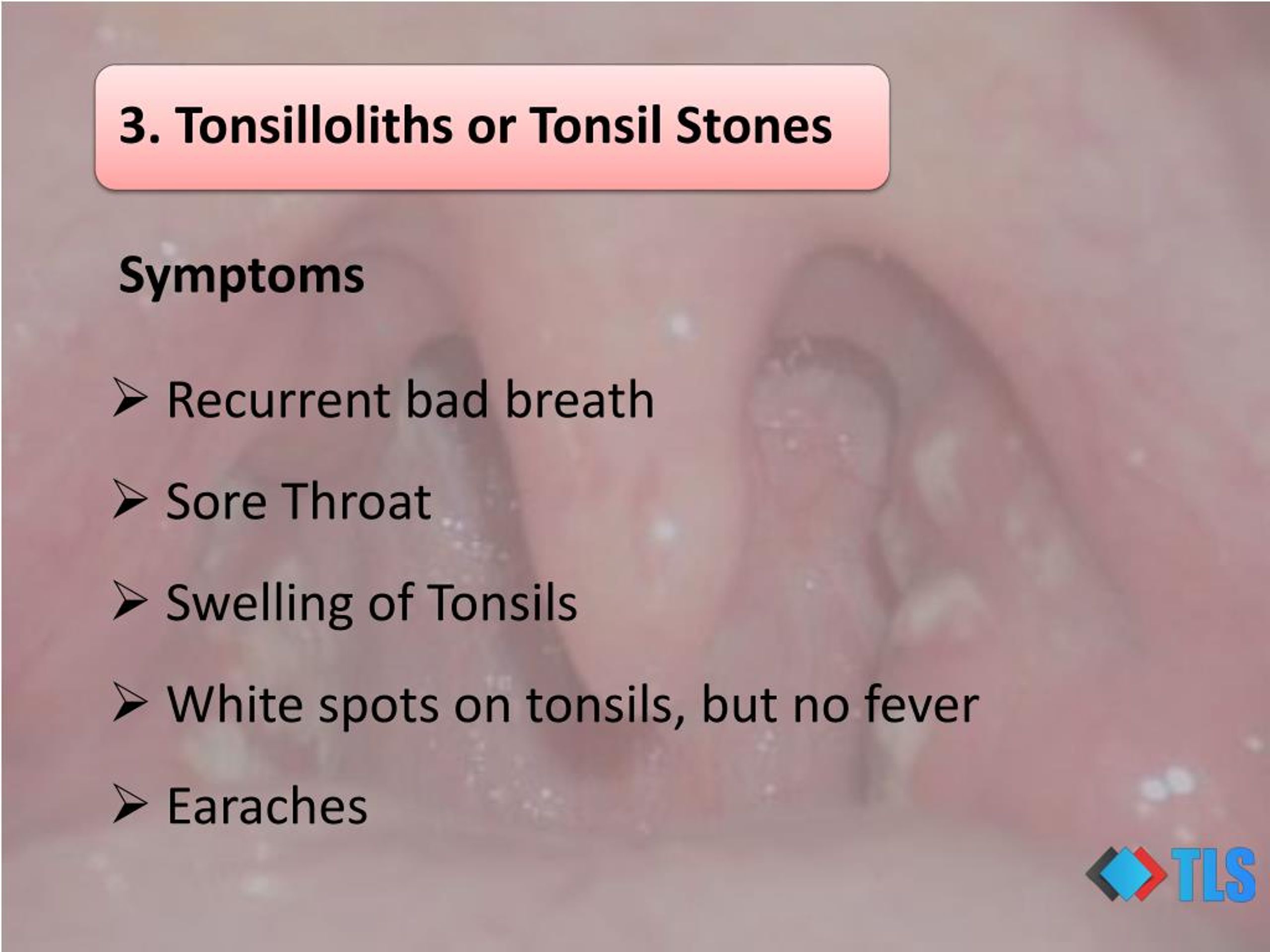
Common viruses that cause sore throats in children:
- adenovirus,
- Coxsackie virus,
- measles virus,
- scarlet fever virus,
- respiratory syncytial virus,
- influenza viruses,
- cytomegalovirus (CMV),
- Epstein-Barr virus (EBV).
As a rule, viral sore throats are relatively safe, because the immune system copes with their pathogens on its own.
Another cause of acute tonsillitis in children is bacteria: group A streptococci, less often staphylococci. Bacterial tonsillitis does not go away on its own and requires mandatory antibacterial treatment.
Common bacteria that cause sore throats in children:
- streptococci,
- Staphylococcus aureus,
- whooping cough.
As a rule, in children from 5 to 15 years, acute tonsillitis is of bacterial origin. In young children – viral.
The main difference between viral and bacterial tonsillitis is the absence of purulent plaque on the tonsils
Ways of transmission of angina in children
Angina itself is not contagious – the danger is the viral and bacterial infections that cause it.
Viruses and bacteria that can lead to acute tonsillitis are found in tiny droplets of saliva or nasal mucus that are spread from an infected person when they cough, sneeze, or talk.
Most often, outbreaks of viral and bacterial tonsillitis are detected in kindergartens, schools, sections
You can get infected less often if you touch surfaces on which virus particles have remained (for example, door handles, remote controls), and then touch your face or eyes with unwashed hands.
Moreover, both bacterial and viral tonsillitis can be contagious 2–3 days before the first symptoms appear.
Development of angina in children
Sore throat causative agents penetrate the mucous membrane of the nose or mouth with inhaled air, less often by household contact.
If the immune system fails to fight the infection, then viruses and bacteria can remain on the tonsils and lead to acute inflammation – tonsillitis.
On average, the incubation period for viral and bacterial infections lasts from 10 to 20 days, during which time the child does not feel any symptoms.
With a decrease in immune defense, infectious agents can spread further: with the blood flow, they are transferred to internal organs, bones, joints and provoke complications.
Symptoms of sore throat in children
Symptoms of angina in children are usually pronounced.
Symptoms of acute tonsillitis in a child:
- sore throat,
- red and swollen tonsils,
- pain when swallowing,
- white or yellowish coating on tonsils,
- painful and enlarged lymph nodes in the neck,
- high temperature,
- headache.
With tonsillitis, purulent plugs may appear on the tonsils, which can be seen if the child opens his mouth wide
It is difficult for young children to describe how they feel, but there are signs by which parents may suspect acute tonsillitis in a child.
Signs of acute tonsillitis in children:
- increased salivation,
- refusal to eat,
- tearfulness.

If the disease becomes chronic, then the symptoms subside temporarily.
Symptoms of chronic tonsillitis in a child:
- Enlarged tonsils and lymph nodes in the neck,
- purulent plugs in the tonsils,
- bad breath.
Complications of tonsillitis in children
In most cases, viral tonsillitis in children resolves on its own. The prognosis is favorable. But a severe bacterial infection or frequent sore throats can lead to complications.
Complications of acute tonsillitis in children:
- inflammation of the middle ear – otitis media;
- inflammation of the mucous membrane of the nasal cavity and paranasal sinuses – rhinosinusitis;
- Apnea is a condition in which a person stops breathing for a short time during sleep. With angina, it is associated with chronic inflammation of the tonsils;
- paratonsillar abscess is an acute inflammatory process that forms in the tissues surrounding the palatine tonsils and leads to the formation of a purulent cavity.

Diagnosis of angina in children
If the general condition of the child worsens – the temperature rises, he refuses to eat and drink, complains of a sore throat – you should call the pediatrician on duty or the ambulance team as soon as possible.
Call an ambulance immediately if your child has:
- temperature above 39°C,
- difficulty swallowing,
- breathing problems,
- confusion,
- vomiting.
Usually a pediatrician or general practitioner can easily diagnose acute tonsillitis on examination. Laboratory tests may be required to confirm the diagnosis.
Inspection
Examination for acute tonsillitis begins with an assessment of the functions of breathing and swallowing. The doctor examines the mucous membrane of the oral cavity, teeth, feels the lymph nodes on the neck.
The next step is the examination of the pharynx. With angina, the child’s throat is red, a whitish purulent coating is visible on the tonsils, and the cervical lymph nodes are enlarged and hurt when pressed.
To assess the condition of the mucous membrane of the throat, the doctor performs a pharyngoscopy – an examination of the pharyngeal cavity using an instrument similar to a magnifying glass with a flashlight
Laboratory diagnostics
To clarify the diagnosis, if acute tonsillitis is suspected, the child is prescribed laboratory blood tests.
Clinical blood test allows you to assess the general state of health and the severity of the inflammatory process.
Clinical blood test with leukocyte formula and ESR (with microscopy of a blood smear in case of pathological changes) (venous blood)
Ven. blood (+140 ₽) 43 1 day
43 bonuses
430 ₽
Add to cart
1 day
Ven. blood 140 ₽
In addition, the severity of inflammation is also indicated by early markers of the inflammatory process: C-reactive protein and procalcitonin.
C-reactive protein
Ven. blood (+140 ₽) 33 1 day
33 bonuses
330 ₽
Add to cart
1 day
Ven. blood 140 ₽
blood 140 ₽
Procalcitonin
Ven. blood (+140 ₽) 174 1 day
174 bonuses
1,740 ₽
Add to cart
1 day
Ven. blood 140 ₽
For retrospective diagnosis of acute streptococcal angina, if infection is suspected to be chronic, and to assess the risk of complications, the doctor may prescribe blood tests for antistreptolysin-O and rheumatoid factor.
Antistreptolysin-O (ASLO)
Ven. blood (+140 ₽) 35 1 day
35 bonuses
350 ₽
Add to cart
1 day
Ven. blood 140 ₽
Rheumatoid factor
Ven. blood (+140 ₽) 35 1 day
35 bonuses
350 ₽
Add to cart
1 day
Ven. blood 140 ₽
If a bacterial nature of the disease is suspected, a swab from the pharynx is sown for microflora and the sensitivity of the pathogen to antibacterial drugs and bacteriophages is determined.
Sowing from the throat for microflora with determining the sensitivity of the pathogen to antibacterial drugs and bacteriophages
Scraping (+250 ₽) 135 5 days
135 bonuses
1 350 ₽
5 days
Scraping 250 ₽
Throat culture for pyogenic streptococcus (Streptococcus pyogenes) with determination of pathogen sensitivity to antibacterial drugs and bacteriophages
Scraping (+250 ₽) 136 3 days
136 bonuses
1 360 ₽
Add to cart
Scraping 250 ₽
Treatment of angina in children
Children with acute tonsillitis are treated by a pediatrician or an otorhinolaryngologist.
Medical treatment
The choice of tactics for treating tonsillitis in a child will depend on the cause of the disease.
virus infection usually clears up on its own in 7 to 10 days.
To relieve the symptoms of a viral sore throat, your doctor may recommend:
- observe bed rest;
- drink plenty of fluids to soothe your throat;
- suck on local anesthetic lozenges or lozenges to relieve a sore throat;
- drink cool drinks, lick popsicles, eat ice cream.
Ice cream and cold drinks will not cure a sore throat, but may relieve the pain. Cold causes local vasoconstriction. As a result, swelling and pain are reduced.
Bacterial infection is treated with a course of antibiotics. It is important to complete the full course of antibiotic therapy prescribed by your doctor to avoid the development of antibiotic resistance (microorganism resistance to the drug). In addition, if treatment is completed earlier, the bacterium can spread throughout the body and lead to complications and chronic infection, which will be more difficult to stop (strong antibiotics in high doses may be required). As a rule, the course of treatment is 10-14 days.
In addition, if treatment is completed earlier, the bacterium can spread throughout the body and lead to complications and chronic infection, which will be more difficult to stop (strong antibiotics in high doses may be required). As a rule, the course of treatment is 10-14 days.
Surgical treatment
If medical treatment does not help and the child becomes worse or has frequent sore throats (more than 5 times a year), the doctor may recommend surgery to remove the tonsils – tonsillectomy.
Scientists and doctors have studied the health of more than 1 million people who had their tonsils, adenoids, or both removed in childhood. In adulthood, such people had a 3-fold increase in the risk of diseases of the upper respiratory tract. But, if the operation is nevertheless prescribed by a doctor, this means that the benefits of tonsillectomy outweigh the potential risk of developing infections in the future.
Tonsils cannot be removed just like that, strict indications are needed for the operation.
Without tonsils, the child’s immune system is deprived of an important protective link.
Tonsillectomy is performed under general anesthesia, the operation lasts an average of 35-40 minutes. The rehabilitation period is not required. As a rule, the child is sent home within a few hours after the operation.
After 7-10 days, the mucous membrane of the pharynx is completely restored.
Prognosis of angina in children
Angina in children, as a rule, is more severe than in adults: with high fever, severe sore throat, bright purulent plaque on the tonsils.
The average duration of treatment for uncomplicated bacterial tonsillitis in a child is no more than 2 weeks. Viral tonsillitis resolves on its own in an average of 7-14 days. The prognosis in both cases is favorable.
Prevention of angina in children
There is no specific prevention of angina in children. The main thing is to maintain general health: eat a varied and balanced diet, walk daily in the fresh air, keep a sleep schedule, wash your hands regularly (especially after returning from the street and from crowded places).
Follicular angina – symptoms, signs, causes and treatment in adults in the “SM-Clinic”
This disease is treated by an Otolaryngologist (ENT)
- What is it?
- Classification
- Symptoms of follicular sore throat
- Causes of follicular angina
- Diagnostics
- Expert opinion
- Treatment
- Prevention of follicular sore throat
- Rehabilitation
- FAQ
- Sources
Classification
Follicular angina may be acute or chronic. In addition, this form is included in the classical classification of angina, which divides the pathology into catarrhal, follicular, lacunar, fibrinous, herpetic, phlegmonous, gangrenous and mixed.
Symptoms of follicular angina
Follicular angina is characterized by a vivid clinical picture, its signs can be:
- intense sore throat – sometimes it hurts not only to speak, but even swallow and breathe; pain may radiate to the ear, temple;
- elevated to febrile values (38-39°C) body temperature, accompanied by chills;
- headache;
- general weakness, fatigue, weakness;
- muscle pain, aching joints and other symptoms of intoxication.

Lymph nodes are often enlarged to such a size that the patient feels them, it hurts him to turn his head to the side, painful lumps are felt on the neck. There is an unpleasant taste and smell in the mouth.
Causes of follicular tonsillitis
Follicular tonsillitis is an infectious disease, and the most common way of its transmission is airborne. In the vast majority of cases, the causative agent is β-hemolytic streptococcus, rarely other microorganisms (staphylococci, pneumococci, other types of streptococci, viruses).
There are factors that increase the risk of developing tonsillitis:
- severe hypothermia;
- low general immunity;
- autoimmune diseases;
- diabetes mellitus;
- severe stress;
- foci of chronic infection in adjacent organs (paranasal sinuses, teeth).
Under the influence of these factors, the risk of developing angina follicularis in adults and children increases significantly.
Get advice
If you experience these symptoms, we recommend that you make an appointment with your doctor. Timely consultation will prevent negative consequences for your health.
To learn more about the disease, prices for treatment and sign up for a consultation with a specialist, you can call:
+7 (495) 292-39-72
Request a call back
Book online
Why SM-Clinic?
1
Treatment is carried out in accordance with clinical guidelines
2
Comprehensive assessment of the nature of the disease and treatment prognosis
3
Modern diagnostic equipment and own laboratory
4 900 05
High level of service and balanced pricing policy
Diagnosis
At the initial stage of the consultation, the doctor will talk with the patient and collect complaints and anamnesis (history) of the disease. Then the doctor will perform a pharyngoscopy – examine the oral cavity and pharynx, assessing the condition, including the tonsils. During the examination, the otolaryngologist uses equipment with lighting, which gives him the opportunity to detect even the slightest signs of ill health of the organs being examined.
During the examination, the otolaryngologist uses equipment with lighting, which gives him the opportunity to detect even the slightest signs of ill health of the organs being examined.
On examination, the ENT will see that the tonsils are swollen, enlarged, bright red in color, and their entire surface is covered with small yellowish-greenish vesicles – these are festering follicles.
Conducting an objective examination, the doctor will identify enlarged submandibular, anterior cervical lymph nodes.
If follicular tonsillitis is suspected, the patient will undergo a general blood test, as well as a bacteriological culture of a swab from the tonsils. This will help identify a specific pathogen, find out the degree of its sensitivity to various antibiotics and allow the doctor to decide on the treatment.
Expert opinion
I would like to draw the reader’s attention to the peculiarities of the course of follicular tonsillitis in children. Their sore throat is not the first symptom, but occurs only on the second or third day of the disease./strep-throat-symptoms-5ae1f28aeb97de003955dcd2.png) And acute tonsillitis debuts suddenly, with pronounced symptoms of general intoxication, often with damage to the meninges (this is evidenced by nausea, vomiting, fainting, convulsions in a child). The patient refuses food, notes the presence of pain in the abdomen, bloating, stool disorders. Such a severe course of the pathological process is an indication for the treatment of a child in an infectious diseases hospital. Parents should not be afraid of this and refuse hospitalization, because the main task is to help the child, alleviate his condition, get rid of the disease.
And acute tonsillitis debuts suddenly, with pronounced symptoms of general intoxication, often with damage to the meninges (this is evidenced by nausea, vomiting, fainting, convulsions in a child). The patient refuses food, notes the presence of pain in the abdomen, bloating, stool disorders. Such a severe course of the pathological process is an indication for the treatment of a child in an infectious diseases hospital. Parents should not be afraid of this and refuse hospitalization, because the main task is to help the child, alleviate his condition, get rid of the disease.
Letkin Alexander Pavlovich
Otorhinolaryngologist of the highest category
Treatment
Treatment of follicular tonsillitis in adults and children is based on rational antibiotic therapy. The patient is prescribed a broad-spectrum antibacterial drug, covering the maximum possible number of potential pathogens. An individual integrated approach of an otolaryngologist in the treatment of angina allows the patient to quickly get rid of the symptoms of intoxication and pain.
The patient may also be prescribed:
- antihistamines;
- oral antiseptics;
- vitamins;
- antipyretic and anti-inflammatory drugs;
- immunomodulators.
In case of severe intoxication, infusions of water-salt solutions (“droppers”) are carried out – detoxification therapy.
The role of local therapies in the treatment of angina follicularis cannot be underestimated. These include:
- frequent rinsing with antiseptic solutions;
- tonsil irrigation;
- inhalation;
- washing the tonsils with the removal of pus;
- physiotherapy treatment (UHF, electrophoresis, magnetotherapy, etc.).
Prevention of follicular angina
Timely sanitation of all sources of chronic infection (sinuses, upper respiratory tract, teeth) will help reduce the risk of developing follicular angina and its complications. And you should also carry out general strengthening activities:
- hardening;
- compliance with the regime of work and rest, good sleep;
- active lifestyle playing sports;
- complete (rational, balanced) nutrition;
- smoking cessation;
- stress prevention.

Rehabilitation
With timely and adequate treatment, follicular tonsillitis regresses in 10-14 days – the patient recovers. Without treatment, it transforms into chronic tonsillitis or leads to the development of systemic complications (myocarditis, endocarditis, arthritis, nephritis, and others) that require regular monitoring by a doctor and medication.
Questions and Answers
The diagnosis of “follicular tonsillitis” can be made after examination by any competent therapist, family doctor or pediatrician. Clarification of the diagnosis and treatment of this disease is the task of the otolaryngologist.
Antibiotics form the basis of treatment. Their doctor prescribes taking into account the characteristics of the clinical picture of your case of the disease. Self-medication is unacceptable and can be dangerous.
No, the treatment of this disease is conservative. Surgery may be indicated to the patient with complications of tonsillitis (for example, if a pharyngeal abscess develops).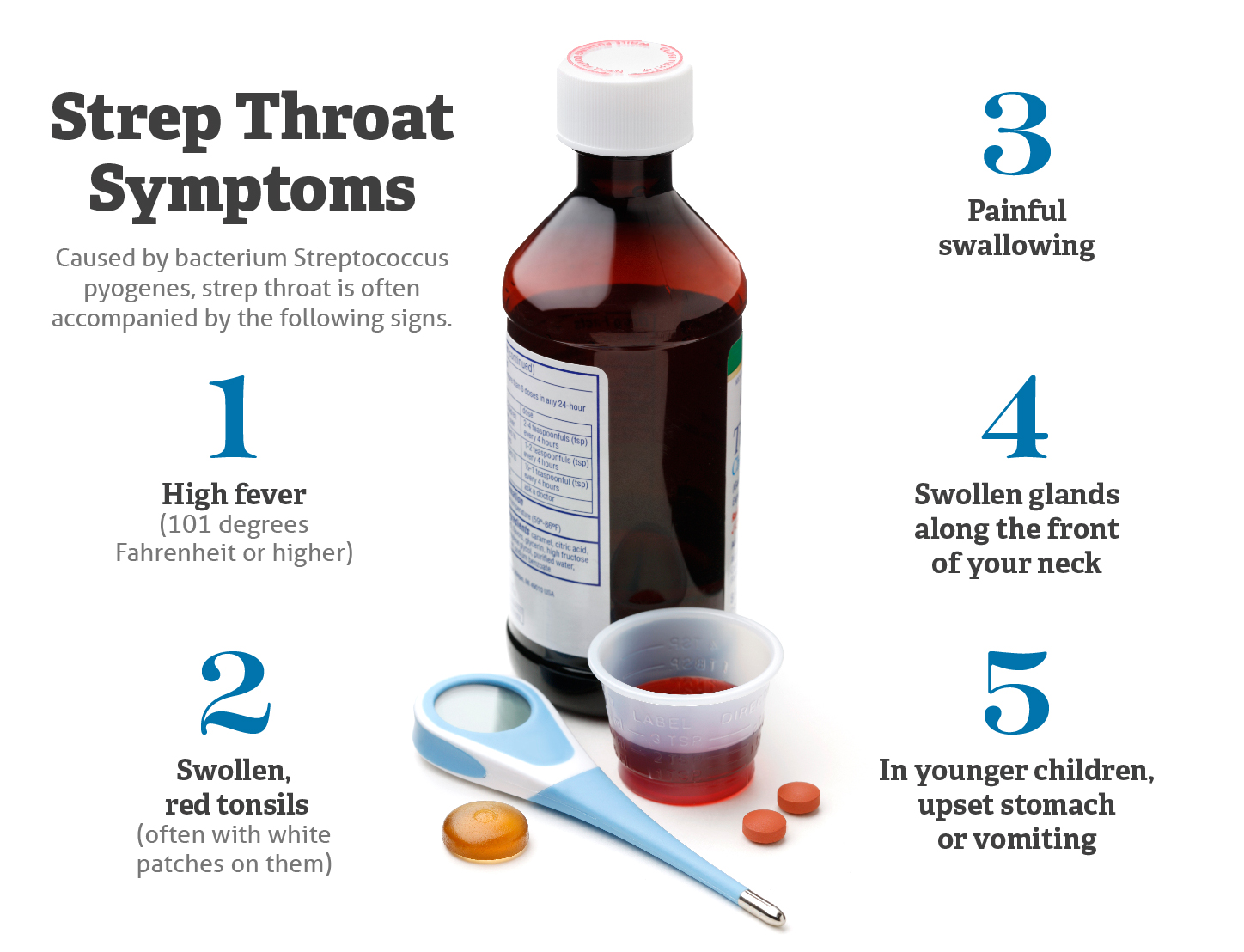
Vladimir Palchun: Otorhinolaryngology. National leadership. Publisher: GEOTAR-Media 2020, 1060 p.
Kunelskaya NL, Turovsky AB, Kudryavtseva Yu. S. Angina: diagnosis and treatment // Medical business. 2010. №3. URL: https://cyberleninka.ru/article/n/anginy-diagnostika-i-lechenie (Date of access: 08/02/2022).
Clinical guidelines (treatment protocol) for the provision of medical care to children with tonsillitis (acute streptococcal tonsillitis). FGBU NIIDI FMBA of Russia, 2015. 29With.
Bacterial diseases: textbook / Ed. N. D. Yushchuk. M.: GEOTAR-Media, 2014. 976 p.
>
Diseases referred by Otolaryngologist (ENT)
Adenoiditis
allergic rhinitis
Angina
Angina catarrhal
Angina lacunar
Meniere’s disease
Inflammation of the lymph nodes
Sinusitis
Purulent otitis media
Diphtheria
Deviated septum
Cyst in sinus
Laryngitis
Otitis externa
Acoustic neuritis
Sensorineural hearing loss
Frontal sinus osteoma
Otitis
Otomycosis
Otosclerosis
nose fracture
Perforation of the tympanic membrane
Polyps in the nose
Polysinusitis
hay fever
Rhinitis
Rhinitis vasomotor
Sulfur plug
Sinusitis
Otitis media
Stenosis of the larynx
Sphenoiditis
Chronic tonsillitis
Tracheitis
Tubootitis (Eustachitis)
Hearing loss (deafness)
Ear noise (tinnitus)
Pharyngitis
Fibroma of the larynx
Frontit
Chronic sinusitis
Chronic rhinitis
Ethmoiditis
All doctors
VDNKh metro station
Belorusskaya metro station
Lesnaya, 57, bld.

 In this case, the symptoms may be less pronounced than in the acute form of the disease.
In this case, the symptoms may be less pronounced than in the acute form of the disease.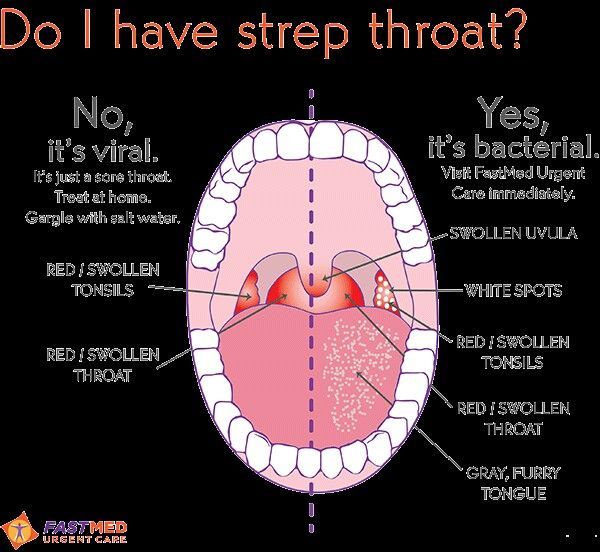

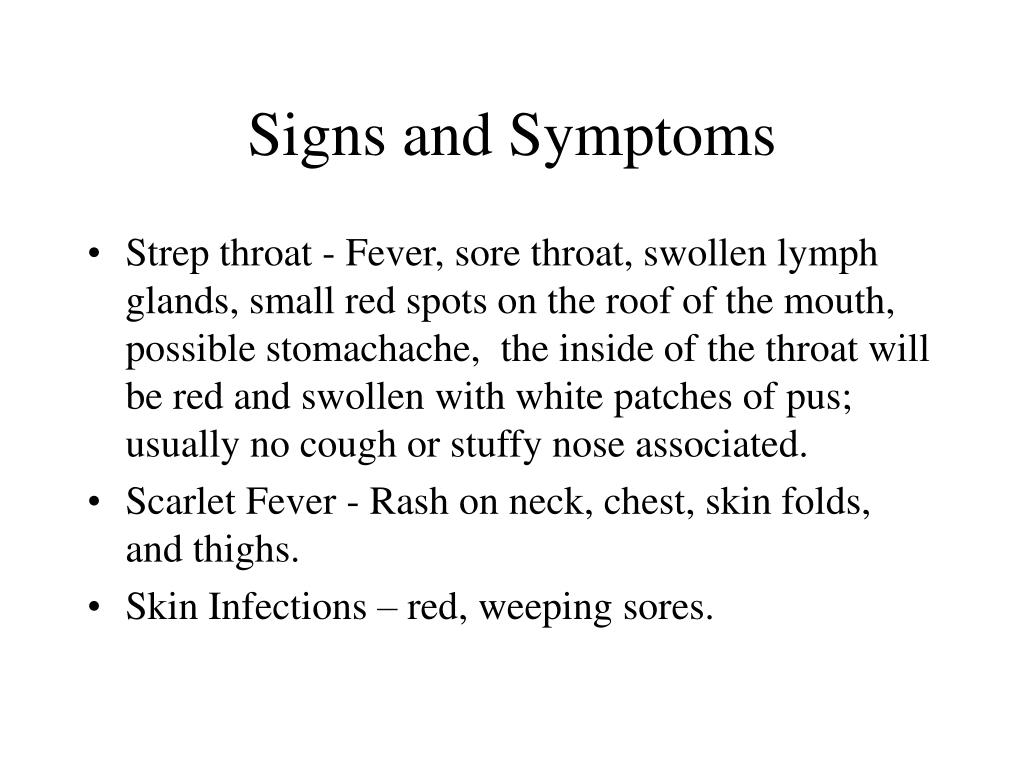
/sore_throat_symptoms-5ae0a8523418c60036278a0f.png) Without tonsils, the child’s immune system is deprived of an important protective link.
Without tonsils, the child’s immune system is deprived of an important protective link.
